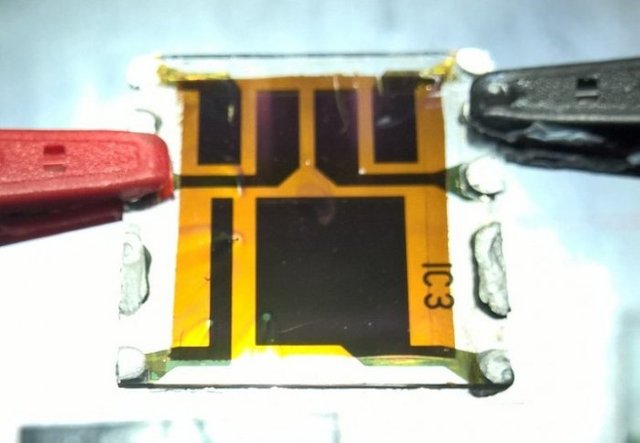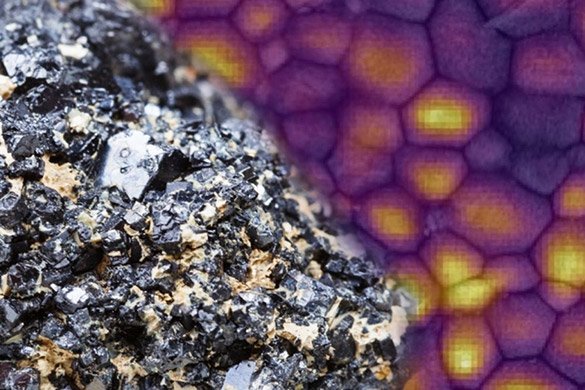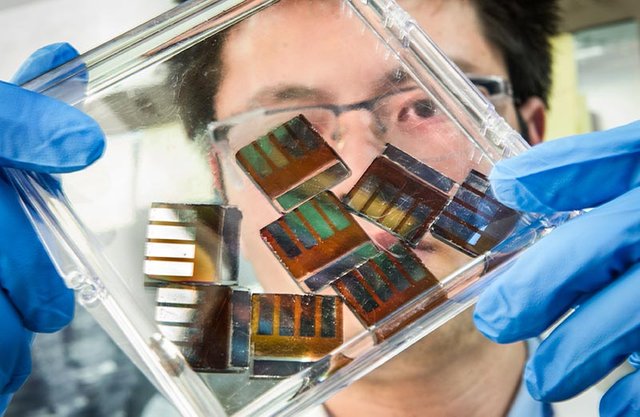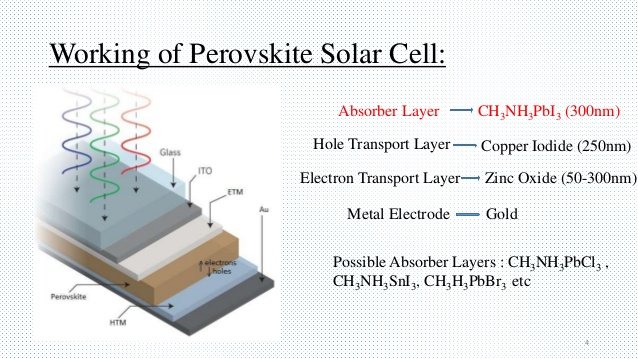Mystery Solar Cell Defect Solved, Will Improve Stability and Market Acceptance
A cause of poor performing solar cells has been identified, leading to a better understanding of how to improve the long term stability and acceptance of solar technology.

source
Photovoltaic solar panels are made from solar cells. Light absorbing material converts sunlight into electricity. The normal material used to absorb the light is silicone, which has an energy intensive and therefore costly manufacturing process.
Perovskites, are a calcium titanium oxide mineral mineral composed of calcium titanate that can be cheaply made from chemicals mixed into printable or sprayable ink that crystallizes to form light absorbing films. These light absorbing films can be made into solar cells to produce electricity.

source
The problem is these perovskite films have defects and how they transfer charges which impair their performance. Slow movement in phase transitions is a lag called hysteresis, leading to irregular inefficient conversion of light into electricity.
Electrons exit a solar cell to be harnessed which is done through contacts onto the light absorbing film. Hysteresis has been removed by using more selective contact materials that ensure a one-way flow of electrons. in theory, changing the contact material shouldn't have any effect on the movement defect of perovskite-based solar cells, yet it did "fix" the hysteresis problem, but scientists didn't know why.
A new study from Imperial College London and published in Nature Communications today Dec. 22nd, developed new experiments to follow which direction electrons move in the solar cell. Previously, photovoltaic current–voltage hysteresis in hybrid perovskite solar cells was thought to be caused by ion migration.

source
But an objection to this hypothesis is that "hysteresis can be reduced by changing the interfacial contact materials". The research shows that "the primary effects of ion migration" are present regardless of contacts being changed. The mobile charged defects are still present in solar cells with very efficient contact materials, even if there is no hysteresis. Hysteresis was only found when the effects of the defects and poor contact were combined. The debate over whether it's the charged defects or the contact material being responsible for hysteresis is over. It turns out the whodunit mystery isn't one single perpetrator, but a "crime" committed by the two parties.
Work to improve solar panel efficiency by only looking at improving the contacts was only looking at one side of the issue. Designers and manufacturers "need to be concerned about the charged defects moving inside the perovskite," says Dr Piers Barnes, from the Department of Physics at Imperial.
These charged defects are a chemical weak point which raises a potential concern over the long-term stability of the solar cells.

source
Commercialization of perovskite solar cells is much closer, but a few challenges must be overcome first. One major concern is that they contain small amounts of lead. In order for public safety to decalre the solar cells safe, a replacement metal will probably have to be found.
Additionally, scientists need to reproduce these laboratory results with life sized solar panels. The biggest hurdle will be to find a way of improving the long-term stability of perovskite-based light-absorbing materials, which this new research at least provides a more clear perspective into where the problem is, compared to previously when they weren't sure what was causing the issue.
Thank you for your time and attention! I appreciate the knowledge reaching more people. Take care. Peace.
References:
- Solved: mystery that was holding back development of next-generation solar cells
- Researchers solve mystery that was holding back development of next-generation solar cells
- Evidence for ion migration in hybrid perovskite solar cells with minimal hysteresis
If you appreciate and value the content, please consider:
@krnel
2016-12-22, 10am

I love all posts about solar, thank you!
My next solar project is setting in parts and pieces on my workbench.
It's a solar D-Link camera which will be housed waterproof, external antenna & lighting added and submerged in our pond.
Hehe, interesting project. Thanks for the feedback.
I <3 all things solar too! I even run a small crowdfunding platform that helps to fund small-scale solar PV installations in rural areas in East Africa.
Very cool and I'm sure rewarding.
This post has been ranked within the top 50 most undervalued posts in the second half of Dec 22. We estimate that this post is undervalued by $8.57 as compared to a scenario in which every voter had an equal say.
See the full rankings and details in The Daily Tribune: Dec 22 - Part II. You can also read about some of our methodology, data analysis and technical details in our initial post.
If you are the author and would prefer not to receive these comments, simply reply "Stop" to this comment.
I hope that the better understanding of solar cells produced by this research will help to manufacture more efficient solar PV panels that will benefit humanity. Who knows, maybe in 5 years from now I will be mining Bitcoin on electricity produced by my own solar panels! ;)
For sure! Solar power is shunned by the power industry, manipulating governments. Off grid living isn't promoted much in North America. Europe has more acceptance.
And I didn't even realize that it was Chemical Week...
I hope they can fix those "week points." 😆
(Sorry, couldn't resist a little teasing!) 😄😇😄

Ya got me :P It's a weak week getting ready for the weekend lol
Interesting and useful information. Thamks.
Thank you for another insightful article krnel!